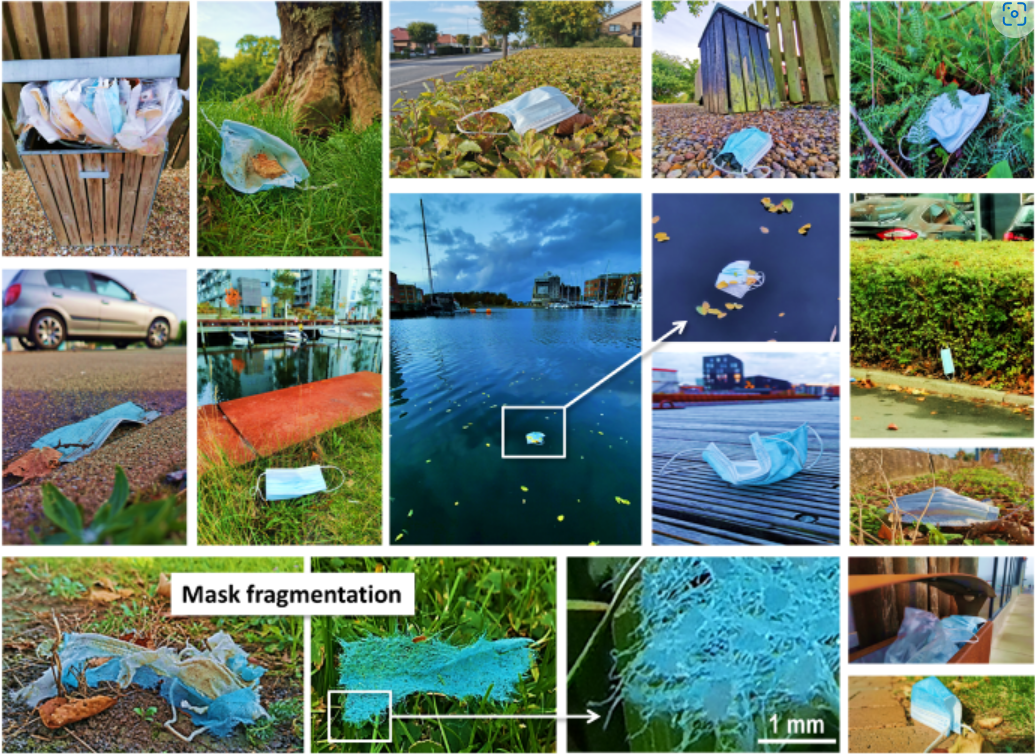The masks we use every day are becoming a major new source of white pollution, following on from rubbish bags. A 2020 study estimates that 129 billion masks will be consumed globally each month, most of which are disposable masks made from plastic microfibre. With the COVID-19 pandemic, disposable masks are being promoted in most countries to prevent COVID-19 infections as they help prevent the spread of COVID-19 and other diseases, and this figure is still being updated.

Disposable surgical masks and mask fragments observed in Odense, Denmark
However, with such high usage rates, no country has an "official" recycling guideline for masks, leaving them more often disposed of as solid waste, which poses an even greater challenge to the global fight against plastic pollution.
There is a pressing need to find a sustainable solution to the global plastic pollution problem caused by single-use masks.
Two biotechnology researchers from the University of Gadjah Mada have recently proposed that epidemic-related mask waste could be treated with biodegradable disposable masks made from pineapple leaves.
The biodegradable disposable masks are mainly made from the fibres of pineapple leaves, as natural fibres are used instead of plastic fibres, enabling microorganisms such as fungi or bacteria to start the degradation process more quickly when they are immersed in soil (expect up to 3 days).
It is understood that pineapples are very commonly grown in the tropics, with information showing that global pineapple production reached 27.82 million tonnes in 2020. The fact that pineapple leaves have one of the highest known cellulose contents of natural fibres (close to 80%) and that there are several ways to extract fibres from pineapple leaves, makes pineapple leaf fibres considered by biotechnology researchers to be a good alternative to plastic fibres.
The pineapple leaf fibre is white, has a silky sheen, has high tensile strength, has a finer texture than other plant fibres (such as hemp, jute, flax and plantain) and can be easily dyed. The arrangement of pineapple leaf fibre is the same as cotton, but it is more environmentally friendly than cotton.
Cotton is traditionally grown using pesticides and fertilisers, and the manufacturing process is treated with harsh chemicals, some of which are retained and cannot be washed away. The pineapple leaves, on the other hand, grow without any supplementary additions and are renewable and readily available every year. As it stands, all but a small proportion of the large amount of pineapple leaves produced each year are made into pineapple leaf fibre and used in the production of raw materials and energy (for example, in the manufacture of products such as rope, twine, composites and clothing).
Often discarded as agricultural waste, the sensible use of these pineapple leaves will not only reduce environmental pollution, but also bring some economic benefits. How important are biodegradable disposable masks to humans? It is understood that common disposable surgical masks consist of three main polymer layers, the outermost layer is a non-absorbent material (e.g. polyester), the middle layer is a non-woven fabric made using a meltblown process (e.g. polypropylene and polystyrene) and the inner layer is an absorbent material such as cotton.
Polypropylene is the most common material used in the production of masks, and they are difficult to break down, making them stay in the ecosystem for decades and possibly centuries before becoming micro- and nano-plastics.
In addition to causing plastic contamination, discarded masks may even accumulate and release harmful chemical and biological substances such as Bisphenol A (BPA), heavy metals and pathogenic microorganisms. Bisphenol A, in particular, has long been identified in studies as a carcinogen. Furthermore, it has also been shown that masks can even be transported from land to the freshwater and marine environment via surface runoff, river flows, ocean currents, wind and animals (through entanglement or ingestion) if not collected and managed properly.
And according to a report released by OceansAsia, a 2020 ocean conservation group, "an estimated 1.56 billion masks will enter the ocean in 2020, which will result in an additional 4,680-6,240 tons of marine plastic pollution."

Potential environmental fate and impact of disposable surgical masks
It's safe to say that as the epidemic becomes normalised, mask waste will only accumulate and cause more and more pollution to the ecosystem. Disposable masks made from pineapple leaf fibres may be a solution to plastic pollution caused by masks, as they naturally degrade and do not release harmful toxins. However, the hydrophilic nature of pineapple leaf fibres makes them less robust than plastic. This is a challenge that requires more research to be invested in.

